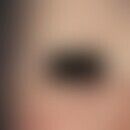Synonym(s)
Giant congenital pigment nevus; giant congential melanocytic nevus; Giant Nevus; Giant pigment nevus congenital; nevus giganteus
DefinitionThis section has been translated automatically.
Congenital, hairy or hairless melanocytic nevus covering large body surfaces with a diameter > 20 cm. If the nevus is located in the buttocks or lumbar region it is called a bathing nevus. A giant pigment nevus can occur as a partial symptom of melanosis neurocutanea.
Occurrence/EpidemiologyThis section has been translated automatically.
Frequency of occurrence: Approx. 1/20,000 newborns.
You might also be interested in
Complication(s)This section has been translated automatically.
In about 5% of patients with melanocytic giant nevi, malignant degenerations are found either within the nevus or extracutaneously. > 50% of all observed malignant degenerations occur within the first 5 years of life. S.a. malignant melanoma in adolescents under melanoma, malign juveniles.
In a larger study (n=976 patients) of patients with congenital melanocytic giant nevi who developed invasive malignant melanoma, "thick" melanomas with lymph node and distant metastasis were observed more frequently. Patients should be observed at close intervals.
TherapyThis section has been translated automatically.
- In medium sized melanocytic nevi, a multiple strip-like excision under general anesthesia is recommended, depending on the location and extent.
- In large giant anevi, which may cover several body parts, dermabrasion should be performed in the first weeks of life. Even if melanocytes in the middle and deep dermis are not included, the risk of melanoma can be significantly reduced by this surgical procedure.
- Instead of dermabrasion, an ablative laser (e.g. Erbium-YAG laser) can also be used for this surgical procedure (only by appropriately experienced colleagues). The final results are apparently comparable.
- If described procedures are not possible, six-monthly clinical check-ups (if necessary photo documentation) and excision of suspicious areas.
Note(s)This section has been translated automatically.
Extensive dermabrasion requires postoperative intensive management and can only be performed in dermatological centres with appropriate facilities.
LiteratureThis section has been translated automatically.
- Bittencourt FV et al (2000) Large congenital melnocytic nevi ant the risk for development of malignant melanoma and neurocutaeous melanocytosis. Pediatrics 106: 736-741
- De Raeve LE et al (2005) Distinct phenotypic changes between the superficial and deep component of giant congenital melanocytic naevi: a rationale for curettage. Br J Dermatol 154: 485-492
- Chaplain EN (1974) The risk of malignancy in large congenital neavi. Plast Reconstr. Surgery 53: 421-428
- Kopf AW et al (1979) Congenital nevocytic nevi and malignant melanomas. J Am Acad Dermatol 1: 123-130
- Turkeltaub AE et al (2016) Characteristics, treatment, and survival of invasive malignant melanoma (MM) in giant pigmented nevi (GPN) in adults: 976 cases from the National Cancer Data Base (NCDB). J Am Acad Dermatol 74:1128-1134.
Incoming links (5)
Giant pigment nevus, congenital; Juvenile melanoma; Mosaic cutaneous; Nevus melanocytic congenital; Nevus pigmentosus et pilosus;Outgoing links (7)
Dermabrasion; Erbium yag laser; Excision; Juvenile melanoma; Melanosis neurocutanea; Naevus melanocytic congenital bathing trunks; Nevus pigmentosus et pilosus;Disclaimer
Please ask your physician for a reliable diagnosis. This website is only meant as a reference.









